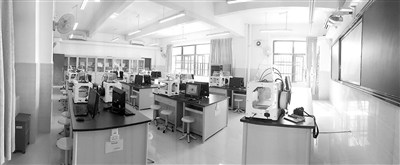Recently, the "3D Printing Technology Education and Teaching Application Collaborative Innovation Center" organized by the Education Equipment Research and Development Center of the Ministry of Education, in 3D printing (VR) in Shenyang, Wuhan, Chengdu, Shenzhen, Jiangmen, Guangzhou, Nanjing, Lanzhou and other places. , AR) Special research on the application status of technology in education and teaching. Through questionnaires, seminars, field trips and classroom observations, 3D printing (VR, AR) technology is not only a growth point for the modernization of educational equipment, but also a new bright spot for driving curriculum innovation. The application in schools at all levels has developed rapidly. Trends, but there are many problems in practice. Not only do they need the guidance of educational innovation theory, but they also need to explore a new path in practice.

Wuhan Sandaojie Primary School students use 3D printing pens to make small crafts

3D Printing Lab of Guangzhou Tieyi Middle School
The application of information technology has become a new topic leading the modernization of educational equipment technology
In the information age, a large number of new equipment and new technologies are emerging, such as artificial intelligence, nanotechnology, 3D printing, big data, graphene and so on. Among them, 3D printing (VR, AR) technology has attracted the attention of education circles in various countries because of its interesting, open, practical, experiential and other characteristics, and has become an important part of the modernization of educational equipment.
In a primary school in the urban area of ​​Guangzhou, the reporter observed the production of 3D modeling under the guidance of the teacher and tried to make crafts with 3D printing pen. In the exchange with reporters, the students showed a strong interest in 3D printing (VR, AR) technology. They believe that these novel technologies can create an "independent learning" environment, establish a variety of virtual laboratories and experience rooms, experience and experience such as space travel, fire and earthquake safety escape, human physiological structure, compound molecular structure, etc. I usually teach the knowledge and skills that are difficult to describe in the classroom.
For 3D printing, the core value is to provide students with a practical carrier of personalized innovation, and to extend the innovative thinking in the real problem situation. 3D printing technology can reflect the design intent and concept of different students. There is no single standard answer. This personalized printing can let students experience the sense of joy and achievement, thus further stimulating students' imagination, cognitive desire and creation. Force to guide students to develop in a deeper field.
Narrow coverage and insufficient teachers have become a "blocker" that hinders the application of 3D printing technology to education.
Due to the unique educational quality of 3D printing (VR, AR) technology, 3D printing equipment has been highly valued by the education equipment department and schools in recent years. In the economically developed areas, there are schools and urban areas featuring equipment and actual The first test of the application.
At present, in the primary school stage, the application of 3D printing technology is mainly embodied in the construction of 3D printing laboratories, the establishment of a community for a small number of students to carry out comprehensive practical activities; in the middle school stage, most of these technologies are used in the maker space. In combination with the specific content of the community to carry out activities; in the vocational education stage, generally through the school-enterprise cooperation form, students can learn the operating practices according to the equipment provided by the enterprise, apply what they have learned, and can operate the enterprise equipment after graduation. Professionalism and directivity, such as mechanical manufacturing, oral technology, etc., but no special courses; and in colleges and universities, there is no special 3D printing technology and courses.
It can be seen that the application of 3D printing technology in primary and secondary schools lacks general general education, but a small and elite education is carried out in the form of associations, and the coverage of applications is relatively narrow. Although some regions and schools have begun to actively explore and have gained some experience, there are still many problems. The main source is that there is no good integration of technology and education, lack of top-level design and practical guidance. For example, in the survey, although most of the respondents were positive about the entry of 3D printing technology into the school, they did not understand enough and had a superficial understanding. In the exchange with reporters, many principals said that 3D printing and other technologies are high in technology, if not for a long time. To solve the problems of supporting teaching materials, curriculum standards and design software, the application of 3D printing in primary and secondary education and teaching will be in the form. Li Dongyun, the principal of Shenyang Jingye Middle School, told reporters that “I am very eager to introduce students to the education of 3D printing (VR, AR) technology. It has been visited many times. Because the country has not yet specified the class hours, some schools have been limited to club activities and become a minority of students. The luxury course is still hesitant."
In addition, the teacher problem is also a "blocking tiger" that hinders the application of 3D printing technology to education and teaching. Since teacher education in China has been practicing single-specialization training and training for a long time, in the application of 3D printing technology to education and teaching, subject teachers generally feel that knowledge and ability structure are not suitable, and can not apply 3D printing new technology to this discipline or multiple disciplines. Knowledge integration is integrated into the teaching activities, so the teaching of this course is mainly taught by information technology or labor technology teachers, and is positioned in non-mainstream courses. Therefore, in order to apply the new technology of 3D printing (VR, AR) to teaching, it is necessary to strengthen the training of professional and technical teachers and key teachers of disciplines, and strengthen the close cooperation of teaching and research.
Courses and equipment go hand in hand to promote the deep integration of 3D printing technology and education in the experimental area
Through the visit to the research site, aiming at the status quo and dilemma of 3D printing technology application, "3D printing technology education teaching application collaborative innovation center" extracted the problem of solving 3D printing (VR, AR) technology education by establishing experimental area as the starting point. The basic ideas and methods, namely "ideal guidance, curriculum guidance, equipment support, experiment first, build a platform, and gradually promote."
First of all, adhere to the people-oriented, and promote overall in collaborative innovation. The advancement of any work must be planned and decided. Local education bureaus and schools have called for promoting 3D printing into classrooms. The Ministry of Education’s equipment authorities must organize expert teams to develop curriculum resources as soon as possible to solve the problems of teaching materials and design software. They must rely on education experts, technical experts, and front-line teachers to conduct in-depth research. Clarify the curriculum concept, content and evaluation criteria, and promote a series of measures to promote the overall coordination.
Secondly, based on the construction of the experimental area, it is steadily advanced under the guidance of educational theory. Establish 3D printing (VR, AR) technical education and teaching application experimental area by city, district (county) as a unit, for all students, in the form of local curriculum, small-scale 3D printing technology education concept, curriculum, equipment configuration and evaluation The experiment, the implementation of teaching practice, the formation of a complete overall solution through experiments, and gradually promoted after gaining experience.
Secondly, vigorously carry out teacher training and combine research to promote the professional growth of teachers. Bi Cheng, a professor at the China Academy of Educational Sciences, said that at present, the most important thing is to solve the problem of teachers and implement technical training for professional teachers and subject teachers in a planned manner. Teachers can master the skills and achieve deep integration of technology and curriculum and teaching practice. . To this end, it is recommended that this new technology training be included in the continuing education of teachers in China. There are two types of teacher training. One is the training of professional teachers of 3D printing (VR, AR) technology, and the other is the integration of technology and subject education. Training of subject teachers is required. At the same time, in the experimental area, a teacher research platform must be established to give full play to the creativity of teachers, so that more teachers can expand the application scope of 3D printing (VR, AR) technology education and teaching through subject research and teaching practice.
Finally, experiment-driven policy innovation and promote the standardization of equipment technology application. When procuring new technical equipment and building laboratories, we should explore an overall allocation mechanism including use, training, service, and guidance, form a new standardization of laboratory construction, and gradually form a new policy orientation, strengthen policy guidance and standardization. Management to ensure that educational equipment technology education functions are maximized.
In short, the popularization of 3D printing (VR, AR) technology in education and teaching has shown the strong potential of new technology to drive educational innovation. Cao Zhixiang, director of the Education Equipment Research and Development Center of the Ministry of Education, said that the education equipment authorities must closely cooperate with educational research institutions, modern educational equipment technology R&D and production enterprises, and schools to promote the overall supporting 3D printing curriculum through collaborative innovation of technology and education. , teacher training, laboratory construction standards, teaching resource allocation and teaching evaluation, etc., at the same time study VR, AR technology education and teaching application model, and use this as a guide to promote the modernization of China's educational equipment technology into a standardized, standardized, scientific New stage.
Glass Bowl,Pyrex Bowls,Glass Mixing Bowls,Kitchenaid Glass Bowl
Xi'an ATO International Co., Ltd , https://www.xianato.com